Black and White Chickens for Your Homestead
The distinctive plumage of black and white chickens is a sight to behold, creating a captivating spectacle in any backyard or farm. It’s no surprise that these shades draw the admiration of farmers, gracing their yards with animals bearing these hues, chickens not excluded.
Aside from their striking color patterns, numerous black and white chicken breeds also serve as exceptional meat and egg producers. Yet, with such a plethora to choose from, which black and white chickens capture our hearts the most?
Why Choose Black and White Chickens?
These striking birds aren’t just visually appealing. They’re also renowned for their impressive egg-laying abilities, hardiness, and friendly nature, making them excellent additions to any poultry flock. What’s more, they often offer a taste of heritage, with many breeds dating back centuries. So, why not immerse yourself in the delightful world of black and white chicken breeds?
Top 10 Black and White Chicken Breeds
In the diverse world of chickens, several black and white breeds stand out due to their distinctive appearance, adaptability, and unique traits. Let’s explore some of them!
Plymouth Rock Chicken
The Barred Plymouth Rock, one of the oldest and most esteemed breeds, was once a prominent food source in America, even encouraged for rearing by the government. Known for their friendly disposition, these birds interact well with various breeds and humans, often serving as lap chickens due to their calm nature. With impressive dual-purpose credentials, they provide high-quality meat and nearly unmatched egg production—up to 280 large eggs annually—without excessive broodiness. Despite being talkative, they aren’t loud and tolerate confinement well. These hardy birds have a lifespan of up to eight years, making them an excellent choice for beginners.
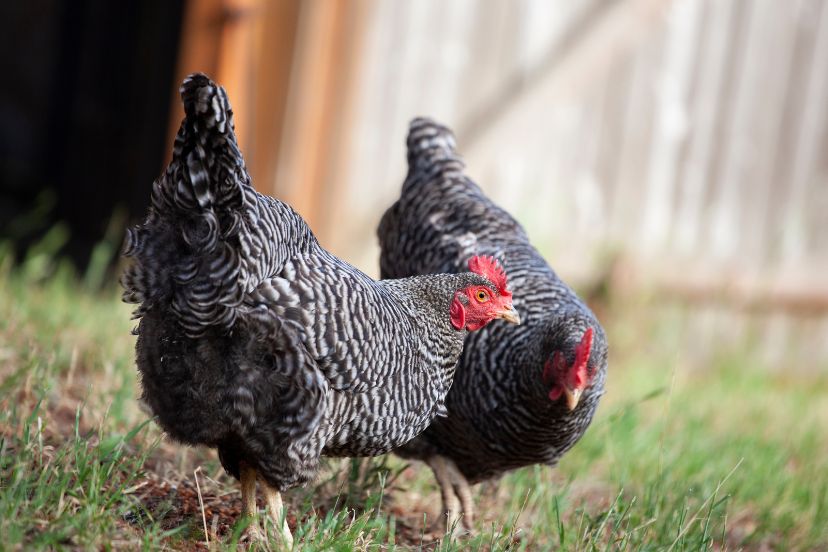
Sussex Chicken
The Light Sussex, an ancient European breed showcased in a 1945 London poultry show, boasts predominantly white feathers accented with black streaks and tail edging. Hardy, disease-resistant, and sociable, they adapt well to varied environments, engaging with other animals and people. As large birds weighing 7-9 pounds, they lay around 250-280 eggs yearly and exhibit slight broodiness, exemplifying their dual-purpose nature.
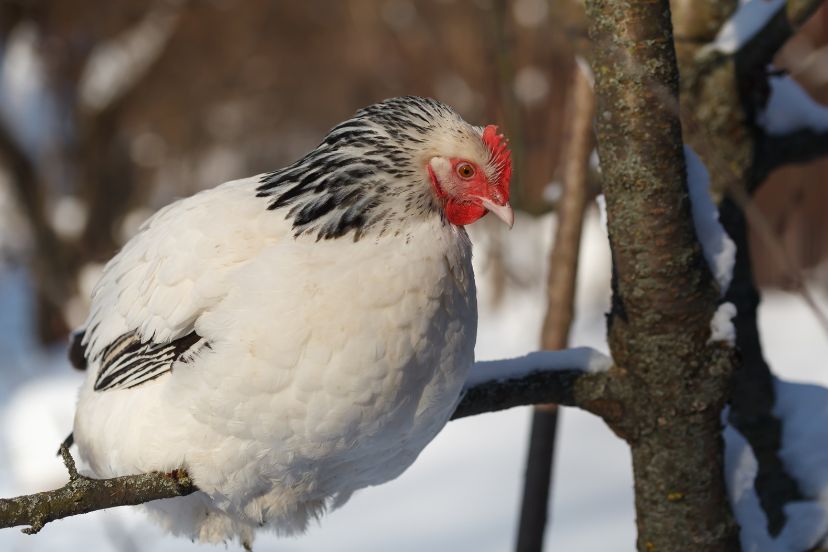
Dominique Chicken
Commonly known as Dominicker or Pilgrim Fowl, Dominiques are often mistaken for Barred Plymouth Rocks, owing to their shared lineage. Yet, their V-shaped pattern distinguishes them. Known for their sweet and calm demeanor, they’re safe around children despite not being lap chickens. These birds are truly multi-purpose, offering great-tasting meat, approximately 250 medium-sized eggs annually, and feather useful for pillows. Notably, they are broody, making them excellent mothers. These quiet and hardy birds can live for over eight years and tolerate confinement well—ideal for urban settings. Be cautious of potential bullying from dominant chickens towards these gentle breeds.
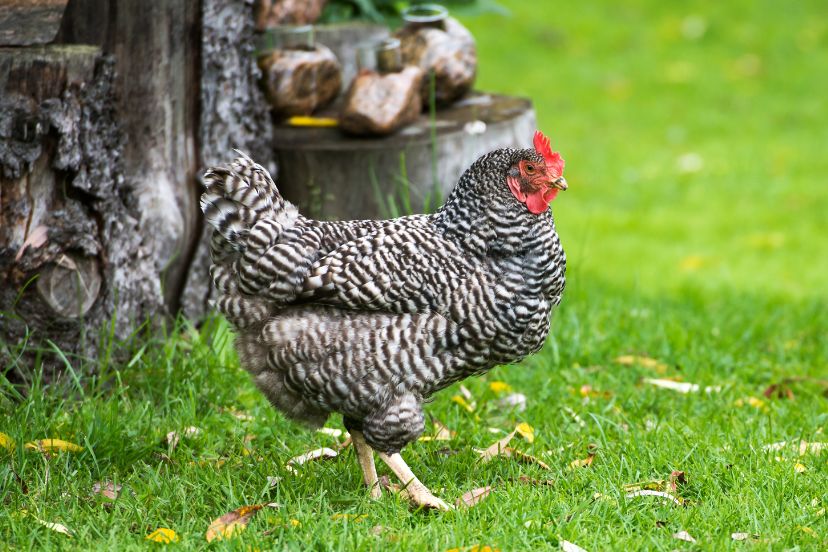
Lakenvelder Chicken
The Lakenvelder, a rare black and white chicken breed, presents a crisp pattern with a predominantly white body and black feathers on its head, neck, and tail. These birds, while somewhat aggressive and assertive, are generally friendly towards humans and their kind but may bully less dominant breeds. Their notable egg-laying ability, yielding around 150 medium-sized eggs annually without broodiness, makes them a useful addition to any flock. With a hardy nature and a lifespan extending over eight years, they adapt well to various climates. Due to their energetic and flighty disposition, they require ample space and don’t thrive in confined settings.
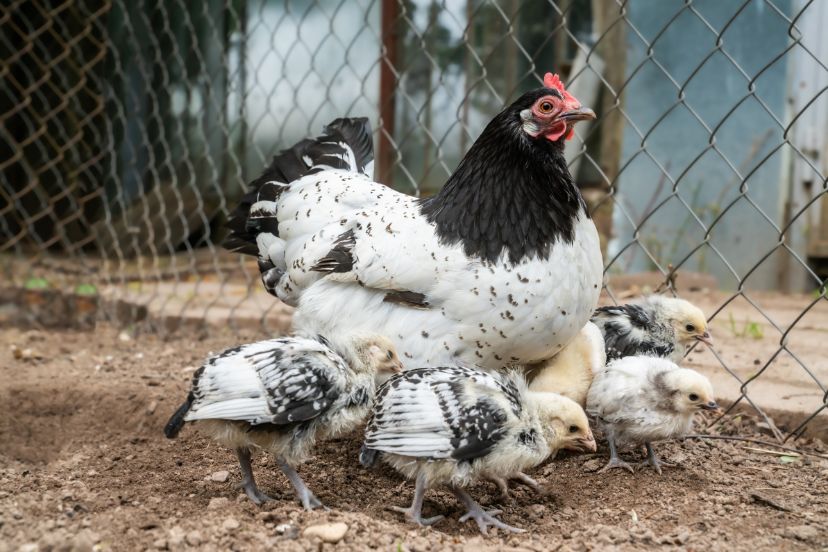
Black Laced Silver Wyandotte
The Black Laced Silver Wyandotte, with its stunning white and silver feathers elegantly lined with black, makes an excellent addition to any flock, not only for its beauty but also its temperament. Renowned for their calm and friendly nature, these chickens tend to stay within their breed, ensuring a harmonious coexistence with other poultry on your farm. While they are peace-loving and unlikely to cause disruptions, they’re assertive enough to defend themselves if necessary. They enjoy human interaction and, while not being lap chickens, they do appreciate your company, albeit with a preference for maintaining their personal space.
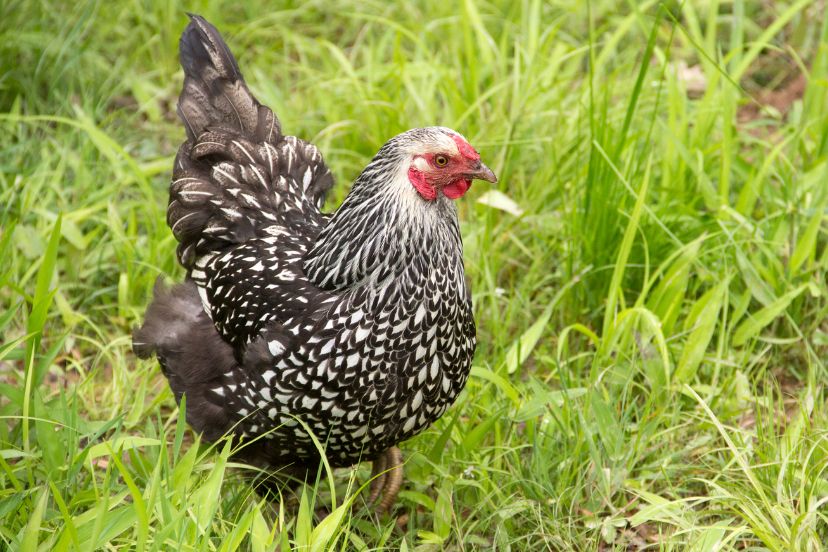
Silver Spangled Hamburg
The Silver Spangled Hamburg, known for its alertness and nervous disposition, uses these traits to effectively evade predators. This elegant breed, a staple at poultry shows due to its remarkable beauty, is a prized sight and nearly ubiquitous in such exhibitions.
Though not preferred as table birds due to their dark bones, Silver Spangled Hamburgs compensate with impressive egg production, yielding over 200 medium-sized eggs yearly. These hardy and healthy birds have a lifespan of up to eight years, with no specific care needs beyond common health concerns. They can be noisy and dislike confinement, but their economical nature, consuming less feed than other breeds, balances out their drawbacks.
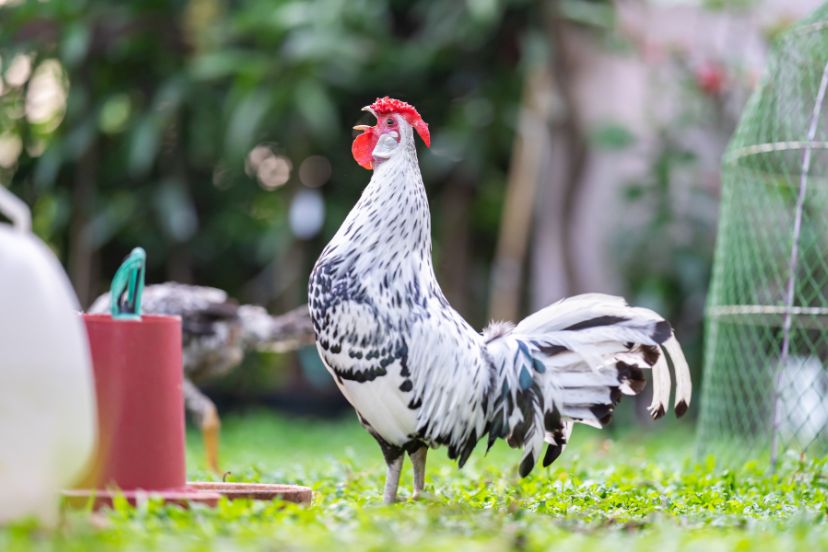
Dark Brahma Chicken
Despite their large size, this breed is known for its gentle nature, making it a wonderful addition to your coop. Known to be friendly and amicable around children, these birds only show signs of aggression when hungry. Once prized for their table qualities, they are now treasured for their unique egg production during off-seasons, maintaining a steady supply of eggs. Their health is robust, typically living up to eight years. Known for their quiet demeanor, their rare vocalizations serve as useful alerts for egg-laying or predator presence. While they tolerate confinement, they appreciate ample roaming space.
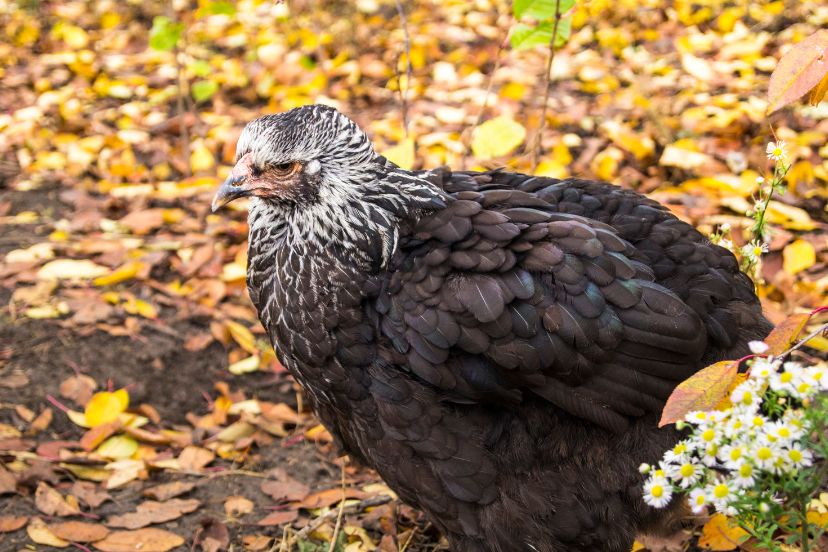
White Crested Black Polish
The White Crested Black Polish is a stunning breed, renowned more for its unique ‘hairdo’ than for its egg production. Despite their striking looks, their crest feathers can cause visibility issues, making them sometimes nervous, but generally, they are mellow and child-friendly. While not prolific layers, they provide around 150 medium-sized eggs per year. They are typically healthy with a lifespan of seven years or more, but require occasional feather trimming to prevent eye infections and enhance visibility.
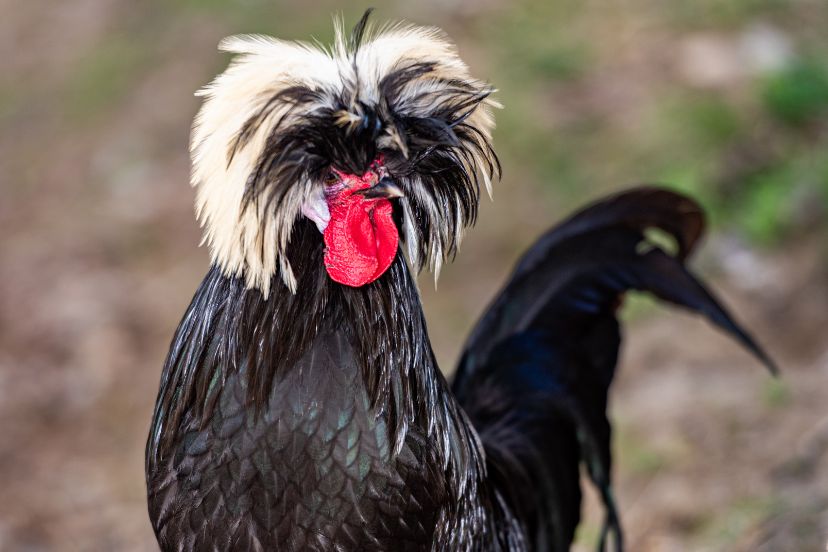
Silver Laced Polish Chicken
The Silver Laced Polish, a native of Poland, is an eye-catching breed with an amusingly unruly feather bonnet that highlights a stunning silver-laced pattern. Their distinct appearance often lands them in poultry shows. These hens are good egg layers, delivering up to 200 eggs annually, without broodiness. While friendly, they can be shy around strangers.
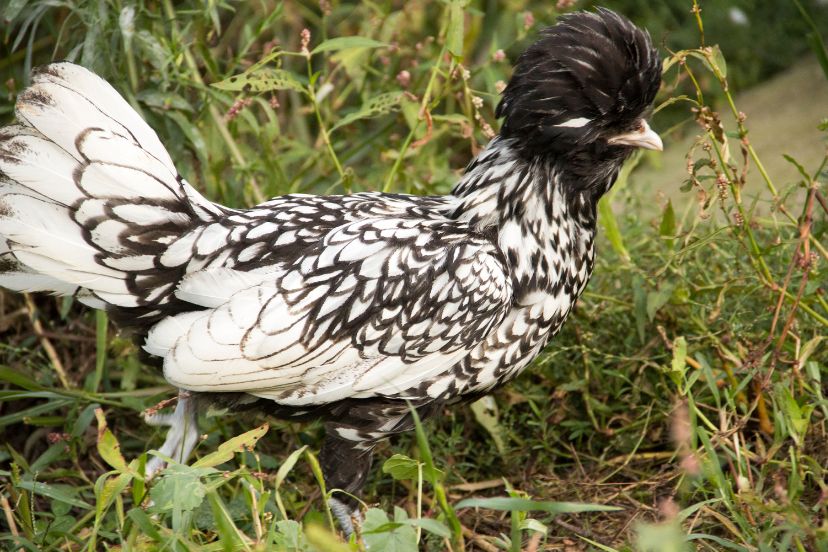
Cuckoo Marans Chicken
Originating from Marans, France, the Cuckoo Marans, often mistaken for the Barred Plymouth Rock breed, is a versatile chicken known for both its meat and egg production. Weighing 7-9 pounds, they lay around 200 uniquely chocolate-colored eggs annually. Their friendly nature and attractive appearance also make them excellent show birds.
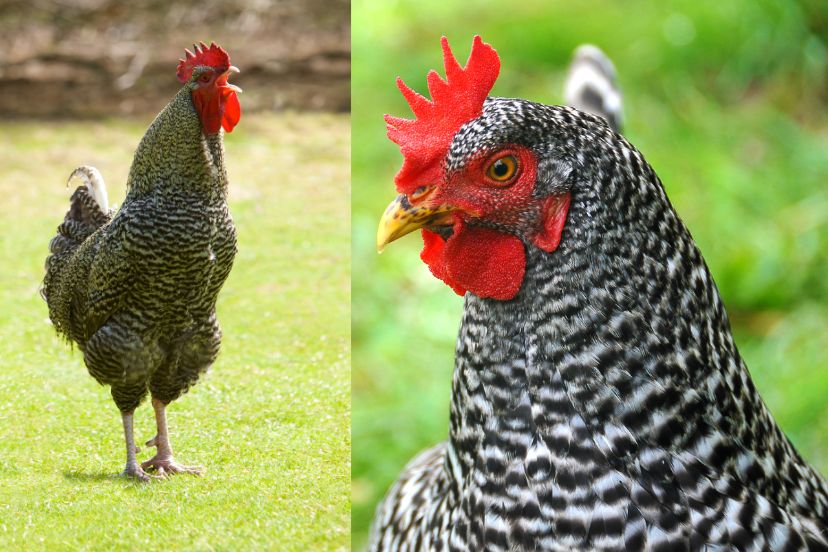
Understanding Chicken Temperaments and Personalities
Recognizing that each chicken breed boasts its unique temperament and personality is key to building a harmonious flock. Many black and white chicken breeds are celebrated for their friendly and docile nature, but it’s vital to remember these characteristics are not universal. Each breed has distinctive traits that determine how well they adapt to your environment, interact with your existing flock, and respond to handling.
For instance, Plymouth Rock chickens are generally calm, easygoing, and hardy. They can tolerate confinement but also thrive in free-range settings, making them perfect for families, including those with children. Conversely, the Lakenvelders are an energetic, inquisitive breed. They enjoy exploring and are better suited for a free-range setup, bringing vibrancy and dynamism to a flock. Therefore, when selecting black and white chicken breeds, consider not just their striking looks but also their unique behavioral traits.
Health and Lifespan of Black and White Chickens
One of the key considerations when selecting a chicken breed to add to your flock is the health and lifespan of the breed. Generally, black and white chicken breeds are known for their robustness and adaptability, factors that contribute to their longevity. With an average lifespan of 5-10 years, these breeds can be a long-term addition to your farm or backyard, providing companionship, eggs, and even meat over a significant period.
However, it’s important to note that a chicken’s lifespan is not solely dependent on its breed or genetic traits. The care provided plays an equally, if not more, important role in determining how long your chickens live. Optimal housing, balanced nutrition, regular health check-ups, and preventative healthcare measures are all integral to extending your chickens’ lives and ensuring their health.
Regular health check-ups help in the early detection of potential health issues, allowing for timely intervention. This can involve a simple physical examination, looking for signs of abnormalities like changes in weight, feather condition, or unusual behavior.
Preventive healthcare, on the other hand, involves actions taken to prevent diseases before they occur. This can include regular deworming, vaccination, and implementing biosecurity measures to reduce the risk of disease transmission.
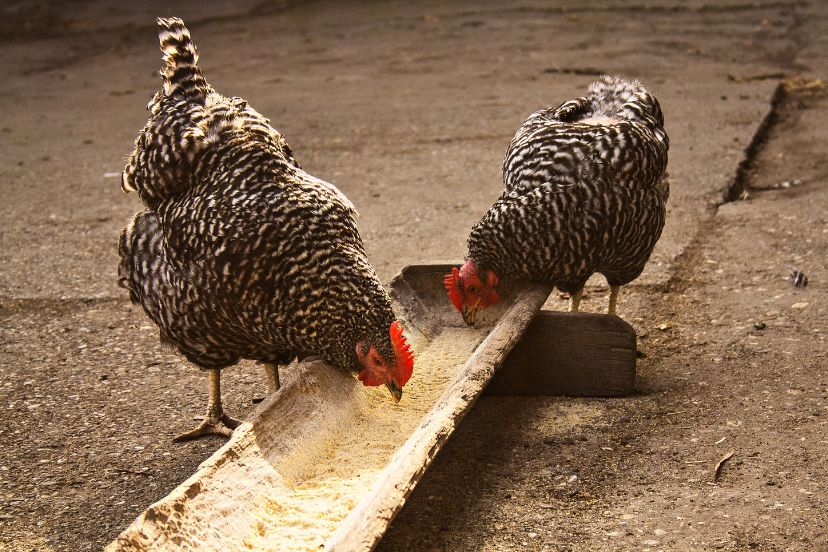
The health and longevity of black and white chicken breeds are largely influenced by the quality of care provided. Regular check-ups and preventative measures are pivotal for optimizing your chickens’ health and lifespan.
Keeping Black and White Chickens: The Essentials
Raising black and white chicken breeds is a rewarding experience, but it’s not without its challenges. Below are some key considerations for keeping these birds healthy and happy.
Housing and Protection
When it comes to raising chickens, one of the key aspects you must consider is housing and protection. Ensuring that your chickens have a secure, comfortable place to live is paramount to their health and productivity.
First and foremost, the coop must provide protection from potential predators. Depending on your location, predators can range from raccoons and foxes to hawks and even neighborhood dogs. Therefore, the coop should be solidly constructed with sturdy materials, and any windows or ventilation holes must be covered with a predator-proof wire mesh. The coop should also be secure from below to protect against digging predators.
In addition to security, your chicken coop should also offer protection against adverse weather conditions. It should be well-insulated for colder climates, yet ventilated enough for hot weather. Ideally, coops should be waterproof, wind-protected, and well-positioned to shield against harsh weather.
Space requirements are another crucial consideration when planning your chicken housing. Overcrowding can lead to stress, disease, and reduced productivity among chickens. As a general rule of thumb, each chicken should have at least 3-4 square feet of space inside the coop. This allows them enough room to move around, feed, and roost comfortably.
Furthermore, if you have the ability to provide an outdoor run, it should ideally offer even more space per chicken. Outdoor runs give chickens the opportunity to scratch, peck, and engage in other natural behaviors, contributing to their overall well-being. These areas should also be securely enclosed to protect against predators and should offer areas of shade for hot days.
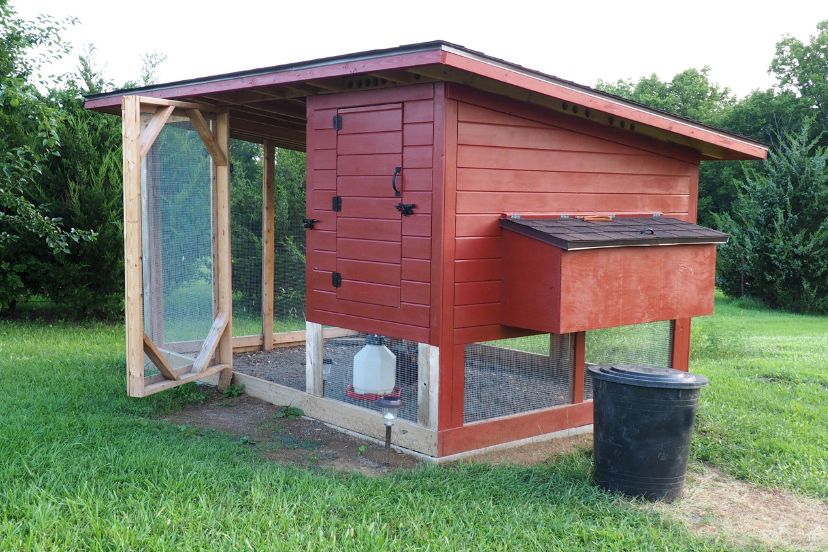
When you’re considering housing and protection for your chickens, your main goals should be to ensure the coop is secure, weather-resistant, and spacious enough for your flock to live comfortably. These elements will contribute to a healthy, happy, and productive flock.
Nutrition and Diet
The cornerstone of healthy, happy, and productive chickens is a well-rounded diet. Chickens, just like any other living beings, need a balanced diet brimming with protein, vitamins, and minerals to maintain optimal health, growth, and productivity.
The typical diet of a chicken should consist mainly of commercial poultry feed. These feeds are scientifically formulated to meet the precise nutritional requirements of your flock. They are packed with the necessary proportions of protein for muscle development and growth, vitamins for boosting immune health, and minerals for bone strength and eggshell formation.
However, while commercial feeds form the staple diet, it’s beneficial to complement this with a variety of kitchen scraps and occasional treats. This not only helps in reducing feed costs but also introduces variety and entertainment into your chickens’ diet, keeping them content and engaged.
Kitchen scraps can include vegetable peels, fruit rinds, leftover pasta or rice, and stale bread. It’s important to note that not all kitchen waste is suitable for chickens – avoid anything salty, fatty, or containing caffeine or alcohol.
Treats can be a fun way to provide extra nutrition and enrichment to your chickens. Common treats include mealworms, sunflower seeds, and even small amounts of dairy like yogurt or cheese. However, remember that treats should make up only a small part of your chickens’ overall diet – no more than 10%.
Finally, always ensure your chickens have access to clean, fresh water. Water plays a vital role in digestion, egg production, and overall body function.
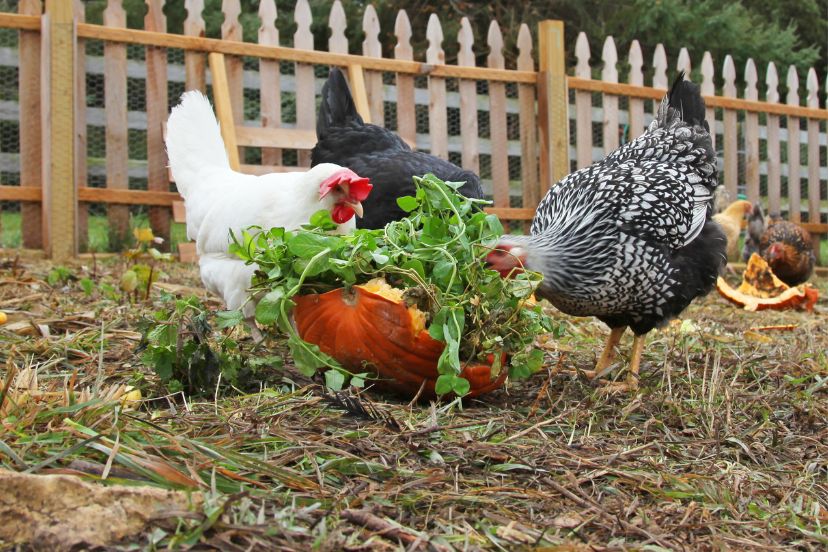
A healthy diet for chickens involves a combination of balanced commercial poultry feed, safe kitchen scraps, occasional treats, and plenty of fresh water. A sound nutritional plan will result in a flock that is healthy, productive, and content.
General Care
Raising a healthy, thriving flock requires constant attention to general care, encompassing routine coop cleaning, consistent access to fresh water, and implementing boredom-busting activities. Keeping the coop clean is vital; this entails regular removal of waste and soiled bedding, disinfecting surfaces, and fresh bedding replenishment. A clean coop mitigates disease spread and deters pests, providing a more comfortable habitat for your chickens.
Access to clean, fresh water is another non-negotiable aspect of chicken care. Water aids in digestion, body temperature regulation, and egg production. Cleaning water containers routinely prevents algae growth and diseases from spreading, thereby safeguarding your flock’s overall health.
Finally, remember that chickens, being naturally curious and active, need mental stimulation. Adding elements like perches in their environment encourages roosting, a natural chicken behavior that also deters ground pests. Similarly, a dust bath area, made with a dry, dust-like substrate like sand or soil, encourages their instinctive behavior to keep their feathers clean and free from parasites. The combination of regular cleaning, adequate hydration, and engaging activities contributes significantly to your flock’s overall wellbeing.
Which Breed is Right for You?
Choosing the right breed ultimately comes down to your specific needs and preferences. Each black and white chicken breed offers unique advantages. Whether it’s the friendly temperament of the Plymouth Rock, the heritage of the Dominique, the dual-purpose nature of the Sussex, or the spirited activity of the Lakenvelder, there’s a black and white chicken breed for every enthusiast.
FAQs
How often do black and white chicken breeds lay eggs? Most black and white chicken breeds lay between 3-5 eggs per week, depending on the breed and their care.
Are black and white chickens good for beginners? Yes, many black and white chicken breeds, like the Plymouth Rock or Dominique, are hardy and friendly, making them excellent for beginners.
What is the lifespan of a black and white chicken breed? Most black and white chicken breeds live between 5-10 years, with some even living longer with proper care.
Can black and white chickens live in cold climates? Yes, most black and white chicken breeds are adaptable and hardy, able to thrive in both cold and hot climates.
Are black and white chicken breeds good for meat? Yes, certain breeds like the Sussex and Plymouth Rock are considered dual-purpose, being suitable for both egg-laying and meat.




